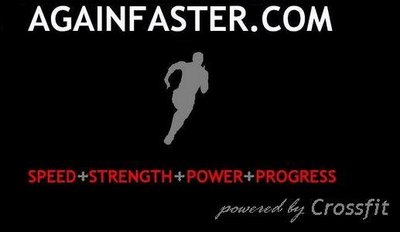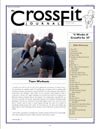How to Use Chalk

Chalk is a very valuable thing in the gym. It allows us to grip the ungrippable. Despite management’s unmitigated understanding of this fact, CrossFit Boston has been without chalk for two weeks.
Imagine an industrial accident at the Johnson & Johnson baby powder factory, and you’ll have a good idea of what the gym looked like after our run-in with “Murph” a few weeks back. Ghostly white palm prints covered the floor is dozens of places, made of that singularly goopy combination of chalk and sweat that requires sandblasting to remove. A nice radius of ultra-fine chalk granules completed the effect.
Imagine cleaning that mess with a half-destroyed sponge mop, and you’ll understand my motives for non-replacement.
Resentment aside, it was a stupid idea. In fact, it was the kind of idea that tort lawyers love. Two nights ago, a good friend and fellow CrossFitter landed on his head after slipping off the pullup bar, going skull-to-irrigation box before crying quietly in the corner. Feeling thankful for his lack of a concussion and the negligence clause in our membership waivers, I spent a whopping $10.50 on a pound of chalk. After removing a used band-aid and a discarded mouthpiece from the repurposed buckets, I added a few blocks of Bison Magnesium Carbonate.
We now have chalk.
What we don’t have is a decent understanding of how to use it. Unlike sex, money, and good friends, it is possible to overdo chalk. The propensity to dip both hands in the bucket, coat them like soon-to-be-fried chicken, and throw them at some fitness apparatus seems like a club sport here at CrossFit Boston.
Ladies and gentlemen, I am here to save you from yourselves. A little bit of chalk goes a long way, and there is a proper way to use it. Chalking your entire hand, from the wrist to the fingertips, is not it. Have you ever gripped anything with the heel of your hand? If so, you’ve overcome the nuisance of the opposable thumb, and I’d like to have a few words with you about an endorsement deal with Again Faster.
The only part of your hand that requires chalk is the part that contacts the bar. This area starts just below the base of the fingers and continues up to the third knuckle. Take a block of chalk, put it on your calluses, swipe upward until you hit your fingertips, and stop. Put the block of chalk down. Now, take your non-chalked hand, rub it against the chalked one, and go about your workout.
You will now be able to grip the ungrippable, and my homicidal tendencies will remain in check for the duration of your training session. Maybe.
Picture of CrossFit Boston after the chalk incident, courtesy of www.iir.com. Okay, it might be a picture of a meth lab with inadequate safety protocols, but who's counting?

Chalk is a very valuable thing in the gym. It allows us to grip the ungrippable. Despite management’s unmitigated understanding of this fact, CrossFit Boston has been without chalk for two weeks.
Imagine an industrial accident at the Johnson & Johnson baby powder factory, and you’ll have a good idea of what the gym looked like after our run-in with “Murph” a few weeks back. Ghostly white palm prints covered the floor is dozens of places, made of that singularly goopy combination of chalk and sweat that requires sandblasting to remove. A nice radius of ultra-fine chalk granules completed the effect.
Imagine cleaning that mess with a half-destroyed sponge mop, and you’ll understand my motives for non-replacement.
Resentment aside, it was a stupid idea. In fact, it was the kind of idea that tort lawyers love. Two nights ago, a good friend and fellow CrossFitter landed on his head after slipping off the pullup bar, going skull-to-irrigation box before crying quietly in the corner. Feeling thankful for his lack of a concussion and the negligence clause in our membership waivers, I spent a whopping $10.50 on a pound of chalk. After removing a used band-aid and a discarded mouthpiece from the repurposed buckets, I added a few blocks of Bison Magnesium Carbonate.
We now have chalk.
What we don’t have is a decent understanding of how to use it. Unlike sex, money, and good friends, it is possible to overdo chalk. The propensity to dip both hands in the bucket, coat them like soon-to-be-fried chicken, and throw them at some fitness apparatus seems like a club sport here at CrossFit Boston.
Ladies and gentlemen, I am here to save you from yourselves. A little bit of chalk goes a long way, and there is a proper way to use it. Chalking your entire hand, from the wrist to the fingertips, is not it. Have you ever gripped anything with the heel of your hand? If so, you’ve overcome the nuisance of the opposable thumb, and I’d like to have a few words with you about an endorsement deal with Again Faster.
The only part of your hand that requires chalk is the part that contacts the bar. This area starts just below the base of the fingers and continues up to the third knuckle. Take a block of chalk, put it on your calluses, swipe upward until you hit your fingertips, and stop. Put the block of chalk down. Now, take your non-chalked hand, rub it against the chalked one, and go about your workout.
You will now be able to grip the ungrippable, and my homicidal tendencies will remain in check for the duration of your training session. Maybe.
Picture of CrossFit Boston after the chalk incident, courtesy of www.iir.com. Okay, it might be a picture of a meth lab with inadequate safety protocols, but who's counting?




















0 Comments:
Post a Comment
<< Home